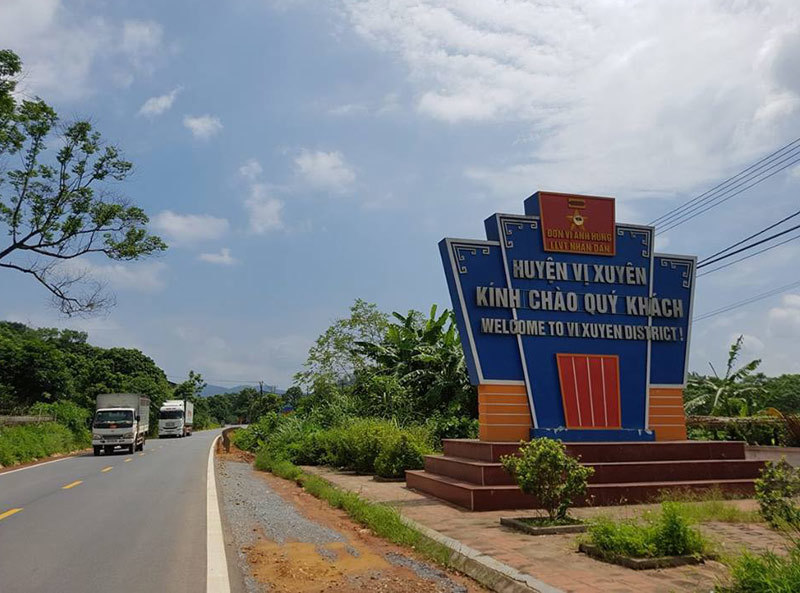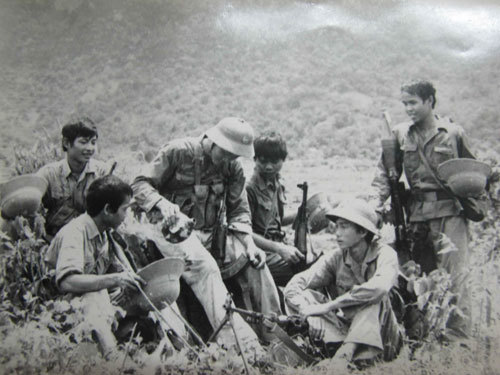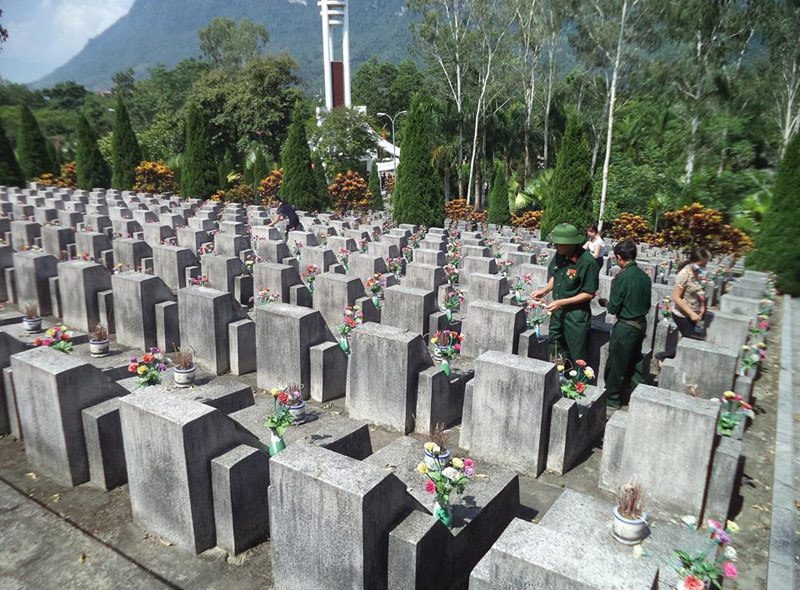Vi Xuyen Front: Unknown stories about July 12, 1984
During the border protection war, Vi Xuyen - Ha Giang was one of the fiercest fronts, with the concentration of military forces and large firepower of the Chinese army. The soldiers of the 9 main divisions of the Vietnam People's Army fought bravely, thousands of them fell.
The country and people will never forget you.
32 years ago, July 12, 1984 was the day of the fiercest battle at the Ha Giang border front with the code name MB84. Since then, July 12 has become the anniversary of the 356th Division, when in just one day, 600 soldiers sacrificed their lives.
 |
| Vi Xuyen - the land at the border of the Fatherland has revived |
In July, Thanh Thuy (Vi Xuyen, Ha Giang) becomes more crowded with people from all over the country. All of them head towards Vi Xuyen Martyrs Cemetery, the memorial house for heroic martyrs on Hill 468... which was just inaugurated at the end of June 2016.
They are veterans who participated in the Thanh Thuy front in the border war 32 years ago.
On July 14, 2016, the Liaison Committee of the Veterans Association of Vi Xuyen - Ha Giang Front, consisting of 31 members, was introduced at the Ministry of National Defense's conference hall with the participation of nearly 600 delegates.
 |
| Major General Nguyen Duc Huy, former Deputy Commander of Military Region 2, Head of the Liaison Committee of the Veterans Association of Vi Xuyen - Ha Giang front. Photo: PX |
Major General Nguyen Duc Huy, former Deputy Commander of Military Region 2, is Head of the Liaison Committee. Lieutenant General Dang Quan Thuy, former Vice Chairman of the National Assembly and former Commander of Military Region 2, is Honorary Chairman.
For the first time, the former Deputy Commander of Military Region 2, who directly commanded the campaign, announced the following figures: More than 4,000 soldiers sacrificed their lives protecting the Vi Xuyen border from 9 main divisions; more than 9,000 wounded and sick soldiers along with many army units directly participated in the battle, repelling the invasion of the Chinese army.
In February 1979, more than 600,000 Chinese troops invaded the Vietnamese border, in some places going as far as 50km inland, destroying and leveling Lao Cai and Cao Bang towns, part of Lang Son town and many villages.
During that war, from April 1984 to May 1989, China successively sent more than 500,000 troops from 8 of the 10 major military regions to comprehensively attack the Ha Giang border, focusing on Vi Xuyen district with the plot to redraw the border to the north of Thanh Thuy stream.
To maintain the border, 9 main divisions along with many regiments and battalions directly participated in the battle at Vi Xuyen front.
The battles to defend the land of the Vietnamese army took place extremely fiercely on the high points 1509, 1100, 772, 685, Doi Dai, Co Ich, Bon Ham... There were high points that were flattened by more than 3 meters of artillery shells, so fierce that they were called "lime kilns of the century". The Vietnamese army and people destroyed and injured tens of thousands of Chinese troops, forcing the Chinese army to withdraw to the other side of the border.
According to Major General Nguyen Duc Huy, there are still more than 2,000 martyrs scattered across the Vi Xuyen battlefield whose remains have not been collected, many martyrs' graves have no names in the cemetery, and thousands of hectares of hills and mountains still have explosives affecting people's lives.
 |
| Veterans of the Vi Xuyen front burn incense to commemorate their comrades on the anniversary of the 356th Division battle, July 12, 2016. |
The reunion in Hanoi after 32 years and 2 days since the fierce battle on July 12, 1984 was not only the expectation and expectation of more than 80,000 soldiers from 9 divisions. Lieutenant General Dang Quan Thuy was extremely moved because this was the first time the meeting was held in more than 30 years.
According to him, in the battle to protect the Vi Xuyen border, our army and people had to confront large, strategic Chinese troops. But we still defeated them, which was a victory of the determination to maintain border sovereignty.
Provincial Party Secretary Trieu Tai Vinh informed: In this war, Ha Giang mobilized 12,000 frontline laborers and 20,000 lowland militiamen to dig tens of thousands of meters of trenches, roads, and provide food and provisions... to build a border defense line against encroachment.
Ha Giang Secretary said: The Central Party Secretariat has agreed to let Ha Giang renovate and embellish Vi Xuyen martyr cemetery into a national cemetery and build a victory monument cluster.
Fire pan in the fence area
According to historical documents, in February 1979, China simultaneously attacked the border of 6 northern provinces. After 30 days of fierce fighting, the local armed forces and ethnic minorities of the 6 border provinces relied on people's war, using the few to fight the many, defeating the "human wave tactics, deep penetration and sabotage" of the Chinese army, forcing them to withdraw from Vietnam on March 18.
 |
| Soldiers aged 18 and 20 participated in the Vi Xuyen front. Documentary photo |
However, China did not completely withdraw its troops but still maintained its forces on the border and in Vietnam's territory, causing the war to continue for the next 10 years.
Since April 1984, gunfire has been constant at the Ha Tuyen border (Ha Giang, Tuyen Quang). China mobilized infantry and artillery to attack and occupy several high points in the Ha Tuyen mountains.
Ha Tuyen is divided into two lines, the front line is the war zone within the range of Chinese encroachment and artillery destruction, and the back line is the relatively stable areas serving the front line.
The border encroachment at the Thanh Thuy and Vi Xuyen fronts was part of the destructive war that China waged after the failure of the large-scale invasion war in the northern border provinces in February 1979. This was a special form of war in terms of combat methods, weapons used, time and space.
In the direction of Military Region 2, with the focus on Vi Xuyen and Thanh Thuy, China concentrated a large force of soldiers and firepower including 4 army groups and 4 independent army corps belonging to 8 major military regions: Kunming, Chengdu, and Nanjing, to take turns attacking and occupying the border area.
 |
| Vi Xuyen Martyrs Cemetery |
China used planes, scouts, and commandos to penetrate deep into Vietnam to grasp the situation, while simultaneously firing mortars, suppressing high points, traffic routes, and infantry forces to attack and encroach on our land. Their fighting style was irregular, regardless of day or night, concentrating on high density and destruction in key areas such as Dai hill, Co Ich, hill 685, Cot Ep, and area 4 bunkers. The average number of bullets and mortars the enemy used each day was from 10,000 to 20,000. Some days it was over 65,000 (January 7, 1987).
For more than 5 years (1984-1989), China fired over 2 million artillery shells at Ha Tuyen, of which 60% were mortar shells. The enemy's shelling range focused on the two communes of Thanh Duc and Thanh Thuy within an area of 20 square kilometers.
To deal with China's plot, Vietnam gathered a large force including main force troops, local troops and militia. The armed forces stationed in 6 northern border provinces numbered about 300,000 people. Vi Xuyen alone - a key direction - regularly had 3 infantry regiments and 2-3 divisions.
At the end of June 1984, Vietnam decided to counterattack. In the battle to regain Hill 772, Division 356 organized dozens of attacks under the pressure of enemy fire from above.
The Vi Xuyen - Thanh Thuy front was identified as the fiercest battle zone in the war against encroachment on the northern border from 1984 to 1989. Within 4 months (April 1984 - August 1984), Vietnam eliminated from combat about 7,500 Chinese troops.
According to Vietnamnet.vn
| RELATED NEWS |
|---|







.png)
